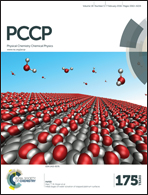Where does methanol lose hydrogen to trigger steam reforming? A revisit of methanol dehydrogenation on the PdZn alloy model obtained from kinetic Monte Carlo simulations†
Abstract
Pd/ZnO is a promising catalyst studied for methanol steam reforming (MSR) and the 1 : 1 PdZn alloy is demonstrated to be the active component. It is believed that MSR starts from methanol dehydrogenation to methoxy. Previous studies of methanol dehydrogenation on the ideal PdZn(111) surface show that methanol adsorbs weakly on the PdZn(111) surface and it is hard for methanol to transform into methoxy because of the high dehydrogenation barrier, indicating that the catalyst model is not appropriate for investigating the first step of MSR. Using the model derived from our recent kinetic Monte Carlo simulations, we examined the process CH3OH → CH3O → CH2O → CHO → CO. Compared with the ideal model, methanol adsorbs much more strongly and the barrier from CH3OH → CH3O is much lower on the kMC model. On the other hand, the C–H bond breaking of CH3O, CH2O and CHO becomes harder. We show that co-adsorbed water is important for refreshing the active sites. The present study shows that the first MSR step most likely takes place on three-fold hollow sites formed by Zn atoms, and the inhomogeneity of the PdZn alloy may exert significant influences on reactions.


 Please wait while we load your content...
Please wait while we load your content...